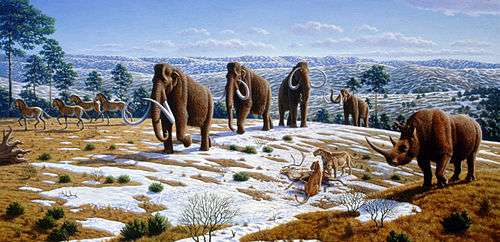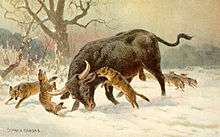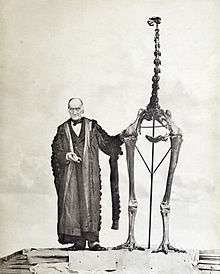Pleistocene megafauna

Pleistocene megafauna is the set of large animals that lived on Earth during the Pleistocene epoch and became extinct during the Quaternary extinction event. Megafauna is a term used to describe an animal with an adult body weight of over 44 kg.
Paleoecology
The last glacial period, commonly referred to as the 'Ice Age', spanned 125,000[1] to 14,500[2] years ago and was the most recent glacial period within the current ice age which occurred during the last years of the Pleistocene era.[1] The Ice Age reached its peak during the last glacial maximum, when ice sheets commenced advancing from 33,000 years BP and reached their maximum positions 26,500 years BP. Deglaciation commenced in the Northern Hemisphere approximately 19,000 years BP, and in Antarctica approximately 14,500 years BP which is consistent with evidence that this was the primary source for an abrupt rise in the sea level 14,500 years ago.[2]
A vast mammoth steppe stretched from Spain across Eurasia and over the Bering land bridge into Alaska and the Yukon where it was stopped by the Wisconsin glaciation. This land bridge existed because more of the planet's water was locked up in glaciation than now and therefore the sea-levels were lower. When the sea levels began to rise this bridge was inundated around 11,000 years BP.[3] During the last glacial maximum, the continent of Europe was much colder and drier than it is today, with polar desert in the north and the remainder steppe or tundra. Forest and woodland was almost non-existent, except for isolated pockets in the mountain ranges of southern Europe.[4]
The fossil evidence from many continents points to the extinction mainly of large animals at or near the end of the last glaciation. These animals have been termed Pleistocene megafauna. The most common definition of megafauna is an animal with an adult body weight of over 44 kg. Across Eurasia, the straight-tusked elephant became extinct between 100,000–50,000 years BP. The hippopotamus, interglacial rhinoceros (Stephanorhinus), cave bear (Ursus spelaeus), and heavy-bodied Asian antelope (Spirocerus) died out between 50,000-16,000 years BP. The spotted hyena, woolly rhinoceros and mammoths died out between 16,000-11,500 years BP. The musk ox died out after 11,500 BP, as did the giant deer (Megaloceros) with the last pocket having survived until about 7,700 years BP in western Siberia.[5] A pocket of mammoths survived on Wrangel Island until 4,500 years BP.[6] As some species became extinct, so too did their predators. Among the top predators, the sabre-toothed cat (Homotherium) died out 28,000 years BP,[7] the cave lion 11,900 years BP,[8] and the leopard in Europe died out 27,000 years BP.[9] The Late Pleistocene was characterized by a series of severe and rapid climate oscillations with regional temperature changes of up to 16 °C, which has been correlated with megafaunal extinctions. There is no evidence of megafaunal extinctions at the height of the LGM, indicating that increasing cold and glaciation were not factors. Multiple events appear to also involve the rapid replacement of one species by one within the same genus, or one population by another within the same species, across a broad area.[10]
The ancestors of modern humans first appeared in East Africa 195,000 years ago.[11] Some migrated out of Africa 60,000 years ago with one group reaching Central Asia 50,000 years ago.[12] From there they reached Europe, with human remains dated 43,000-45,000 years BP discovered in Italy,[13] Britain,[14] and in the European Russian Arctic 40,000 years ago.[15][16] Another group left Central Asia and reached the Yana River, Siberia, well above the Arctic circle 27,000 years ago.[17] Remains of mammoth that had been hunted by humans 45,000 YBP have been found at Yenisei Bay in the central Siberian Arctic.[18] Modern humans then made their way across the Bering land bridge and into North America between 20,000-11,000 years ago, after the Wisconsin glaciation had retreated but before the Bering land bridge became inundated by the sea.[19] These people then populated the Americas. In the Fertile crescent the first agriculture was developing 11,500 years ago.[20]
Theories
Four theories have been advanced as likely causes of these extinctions: hunting by the spreading humans,[21] climatic change, spreading disease, and an impact from an asteroid or comet.[22] These factors are not necessarily exclusive: two or more may have combined to cause the extinctions.
Regions affected
See also: Quaternary Extinction Event
North America


During the American megafaunal extinction event around 12,700 years ago, 90 genera of mammals weighing over 44 kilograms became extinct.[23][24] The Late Pleistocene fauna in North America included giant sloths; short-faced bears; several species of tapirs; peccaries (Including the long nosed and flat-headed peccaries); the American lion; giant tortoises; Miracinonyx ("American cheetahs", not true cheetahs); saber-toothed cats like Smilodon and the scimitar cat, Homotherium;[25] dire wolves; saiga; camelids such as two species of now extinct llamas and Camelops;[26] at least two species of bison; stag-moose; the shrub-ox and Harlan's muskox; 14 species of pronghorn (of which 13 are now extinct); horses; mammoths and mastodons; the beautiful armadillo and the giant armadillo-like Glyptotherium [27] and giant beavers as well as birds like giant condors and other teratorns. The nine-foot sabertooth salmon lived at the time as well. In contrast, today the largest North American land animal is the American bison.[28]
South America
South American wildlife in the Pleistocene varied greatly, an example is the giant ground sloth, Megatherium.[29] The continent also had quite a few grazers and mixed feeders such as the camel-like litoptern Macrauchenia, Cuvieronius, Stegomastodon, Doedicurus, Glyptodon, Hippidion and Toxodon. The main predators of the region were Arctotherium and Smilodon.
Australia
Australia was characterized by marsupials, monotremes, crocodilians, testudines, monitors and numerous large flightless birds. Pleistocene Australia also supported the large short-faced kangaroo (Procoptodon goliah), Diprotodon (a giant wombat), the marsupial lion (Thylacoleo carnifex), the flightless birds Genyornis and Dromornis, the 5-meter snake Wonambi and the giant lizard, the megalania.[30][31]
Eurasia
As with South America, some elements of Eurasian megafauna were similar to those of North America. Among the most recognizable Eurasian species are the woolly mammoth, steppe mammoth, straight-tusked elephant, aurochs, steppe bison, cave lion, cave bear, cave hyena, Homotherium, Irish elk, giant polar bears, woolly rhinoceros, Merck's rhinoceros, narrow-nosed rhinoceros, and Elasmotherium. In contrast today the largest European land mammal is the European bison or wisent.
Insular
Many islands had unique megafauna that became extinct upon the arrival of humans more recently (over the last few millennia and continuing into recent centuries). These included dwarf woolly mammoths on Wrangel Island, St. Paul Island and the Channel Islands of California;[32] giant bird forms in New Zealand such as the moas and Harpagornis (a giant eagle); giant lemurs, including Megaladapis and Palaeopropithecus species and Archaeoindris, a gorilla-sized lemur, three species of hippopotamus, a giant tortoise, the Voay-crocodile and the gigantic Aepyornis in Madagascar; various giant tortoise species from the Mascarenes, a dwarf Stegodon on Flores and a number of other islands; ; land turtles and crocodiles in New Caledonia; giant owls and dwarf ground sloths in the Caribbean;,[33][34] giant geese and moa-nalo (giant ducks) in Hawaii; and dwarf elephants and dwarf hippos from the Mediterranean islands. The Canary Islands was inhabited by endemic animals, such as some extinct; giant lizards (Gallotia goliath), giant rats (Canariomys bravoi and Canariomys tamarani)[35] and giant tortoises (Geochelone burchardi and Geochelone vulcanica),[36] among others.
See also
References
- 1 2 Intergovernmental Panel on Climate Change (UN). "IPCC Fourth Assessment Report: Climate Change 2007 - Palaeoclimatic Perspective". The Nobel Foundation.
- 1 2 Clark, P. U.; Dyke, A. S.; Shakun, J. D.; Carlson, A. E.; Clark, J.; Wohlfarth, B.; Mitrovica, J. X.; Hostetler, S. W.; McCabe, A. M. (2009). "The Last Glacial Maximum". Science. 325 (5941): 710. doi:10.1126/science.1172873. PMID 19661421.
- ↑ Elias, Scott A.; Short, Susan K.; Nelson, C. Hans; Birks, Hilary H. (1996). "Life and times of the Bering land bridge". Nature. 382 (6586): 60. doi:10.1038/382060a0.
- ↑ Jonathan Adams. "Europe during the last 150,000 years". Oak Ridge National Laboratory, Oak Ridge, USA.
- ↑ Stuart, Anthony John (1999). "Extinctions in Near Time": 257. doi:10.1007/978-1-4757-5202-1_11. ISBN 978-1-4419-3315-7.
|chapter=ignored (help) - ↑ Dale Guthrie, R. (2004). "Radiocarbon evidence of mid-Holocene mammoths stranded on an Alaskan Bering Sea island". Nature. 429 (6993): 746–749. doi:10.1038/nature02612. PMID 15201907.
- ↑ Reumer, Jelle W. F.; Rook, Lorenzo; Van Der Borg, Klaas; Post, Klaas; Mol, Dick; De Vos, John (2003). "Late Pleistocene survival of the saber-toothed cat Homotheriumin northwestern Europe". Journal of Vertebrate Paleontology. 23: 260. doi:10.1671/0272-4634(2003)23[260:LPSOTS]2.0.CO;2.
- ↑ Barnett, R.; Shapiro, B.; Barnes, I. A. N.; Ho, S. Y. W.; Burger, J.; Yamaguchi, N.; Higham, T. F. G.; Wheeler, H. T.; Rosendahl, W.; Sher, A. V.; Sotnikova, M.; Kuznetsova, T.; Baryshnikov, G. F.; Martin, L. D.; Harington, C. R.; Burns, J. A.; Cooper, A. (2009). "Phylogeography of lions (Panthera leo ssp.) reveals three distinct taxa and a late Pleistocene reduction in genetic diversity". Molecular Ecology. 18 (8): 1668–1677. doi:10.1111/j.1365-294X.2009.04134.x. PMID 19302360.
- ↑ Ghezzo, Elena; Rook, Lorenzo (2015). "The remarkable Panthera pardus (Felidae, Mammalia) record from Equi (Massa, Italy): Taphonomy, morphology, and paleoecology". Quaternary Science Reviews. 110: 131. doi:10.1016/j.quascirev.2014.12.020.
- ↑ Cooper, A.; Turney, C.; Hughen, K. A.; Brook, B. W.; McDonald, H. G.; Bradshaw, C. J. A. (2015). "Abrupt warming events drove Late Pleistocene Holarctic megafaunal turnover". Science. 349 (6248): 602. doi:10.1126/science.aac4315. PMID 26250679.
- ↑ White, T. D.; Asfaw, B.; Degusta, D.; Gilbert, H.; Richards, G. D.; Suwa, G.; Clark Howell, F. (2003). "Pleistocene Homo sapiens from Middle Awash, Ethiopia". Nature. 423 (6941): 742–7. doi:10.1038/nature01669. PMID 12802332.
- ↑ "A Human Journey:Migration Routes". The genographic project. National Geographic Society. 2015. Retrieved 2015. Check date values in:
|access-date=(help) - ↑ Benazzi, S.; Douka, K.; Fornai, C.; Bauer, C. C.; Kullmer, O.; Svoboda, J. Í.; Pap, I.; Mallegni, F.; Bayle, P.; Coquerelle, M.; Condemi, S.; Ronchitelli, A.; Harvati, K.; Weber, G. W. (2011). "Early dispersal of modern humans in Europe and implications for Neanderthal behaviour". Nature. 479 (7374): 525. doi:10.1038/nature10617. PMID 22048311.
- ↑ Higham, T.; Compton, T.; Stringer, C.; Jacobi, R.; Shapiro, B.; Trinkaus, E.; Chandler, B.; Gröning, F.; Collins, C.; Hillson, S.; o’Higgins, P.; Fitzgerald, C.; Fagan, M. (2011). "The earliest evidence for anatomically modern humans in northwestern Europe". Nature. 479 (7374): 521. doi:10.1038/nature10484. PMID 22048314.
- ↑ Pavlov, Pavel; Svendsen, John Inge; Indrelid, Svein (2001). "Human presence in the European Arctic nearly 40,000 years ago". Nature. 413 (6851): 64. doi:10.1038/35092552. PMID 11544525.
- ↑ "Mamontovaya Kurya:an enigmatic, nearly 40000 years old Paleolithic site in the Russian Arctic" (PDF).
- ↑ Pitulko, V. V.; Nikolsky, P. A.; Girya, E. Y.; Basilyan, A. E.; Tumskoy, V. E.; Koulakov, S. A.; Astakhov, S. N.; Pavlova, E. Y.; Anisimov, M. A. (2004). "The Yana RHS Site: Humans in the Arctic Before the Last Glacial Maximum". Science. 303 (5654): 52–6. doi:10.1126/science.1085219. PMID 14704419.
- ↑ Pitulko, V. V.; Tikhonov, A. N.; Pavlova, E. Y.; Nikolskiy, P. A.; Kuper, K. E.; Polozov, R. N. (2016). "Early human presence in the Arctic: Evidence from 45,000-year-old mammoth remains". Science. 351 (6270): 260. doi:10.1126/science.aad0554. PMID 26816376.
- ↑ Tamm, E.; Kivisild, T.; Reidla, M.; Metspalu, M.; Smith, D. G.; Mulligan, C. J.; Bravi, C. M.; Rickards, O.; Martinez-Labarga, C.; Khusnutdinova, E. K.; Fedorova, S. A.; Golubenko, M. V.; Stepanov, V. A.; Gubina, M. A.; Zhadanov, S. I.; Ossipova, L. P.; Damba, L.; Voevoda, M. I.; Dipierri, J. E.; Villems, R.; Malhi, R. S. (2007). Carter, Dee, ed. "Beringian Standstill and Spread of Native American Founders". PLoS ONE. 2 (9): e829. doi:10.1371/journal.pone.0000829. PMC 1952074
 . PMID 17786201.
. PMID 17786201. - ↑ Balter, M (4 July 2013). "Farming Was So Nice, It Was Invented at Least Twice". Science.
- ↑ Marc A. Carrasco, Anthony D. Barnosky, Russell W. Graham Quantifying the Extent of North American Mammal Extinction Relative to the Pre-Anthropogenic Baseline plosone.org December 16, 2009
- ↑ Nickerson, Colin (September 25, 2007), Cosmic blast may have killed off megafauna Scientists say early humans doomed, too, Boston, MA: The Boston Globe, p. A2.
- ↑ O'Keefe FR,Fet EV,Harris JM. 2009. Compilation, calibration, and synthesis of faunal and floral radiocarbon dates, Rancho La Brea, California. Contrib Sci 518: 1–16
- ↑ O'Keefe, F. Robin, Binder, Wendy J., Frost, Stephen R., Sadlier, Rudyard W., and Van Valkenburgh, Blaire 2014. Cranial morphometrics of the dire wolf, Canis dirus, at Rancho La Brea: temporal variability and its links to nutrient stress and climate. Palaeontologia Electronica Vol. 17, Issue 1;17A; 24p;
- ↑ L. D. Martin. 1998. Felidae. In C. M. Janis, K. M. Scott, and L. L. Jacobs (eds.), Evolution of Tertiary Mammals of North America 1:236-242
- ↑ R. M. Nowak. 1991. Walker's Mammals of the World. Maryland, Johns Hopkins University Press (edited volume) II
- ↑ "North American Glyptodon". Retrieved July 2, 2014.
- ↑ Ice Age Animals
- ↑ A. E. Zurita, A. A. Carlini, G. J. Scillato-Yané and E. P. Tonni. 2004. Mamíferos extintos del Cuaternario de la Provincia del Chaco (Argentina) y su relación con aquéllos del este de la región pampeana y de Chile. Revista geológica de Chile 31(1):65-87
- ↑ Australia's Megafauna
- ↑ Death of the Megafauna
- ↑ Extinct dwarf elephants from the Mediterranean islands;
- ↑ North American Extinctions v. World
- ↑ Mammoths and Humans as late Pleistocene contemporaries on Santa Rosa Island, Institute for Wildlife Studies 6th California Islands Symposium, Larry D. Agenbroad, et al, December 2003. Retrieved 8 November 2015
- ↑ Algunas extinciones en Canarias Consejería de Medio Ambiente y Ordenación Territorial del Gobierno de Canarias
- ↑ «La Paleontología de vertebrados en Canarias.» Spanish Journal of Palaeontology (antes Revista Española de Paleontología). Consultado el 17 de junio de 2016.
External links
- "Ice Age Bay Area".
- "The Extinct Late Pleistocene Mammals of North America".
- "End of the Big Beasts".
- "Of mice, mastodons and men: human-mediated extinctions on four continents" (PDF).
- "Return to the Ice Age: The La Brea Exploration Guide".
- "Large Collection of European Ice Age Megafauna Fossils: The World Museum of Man Collection".